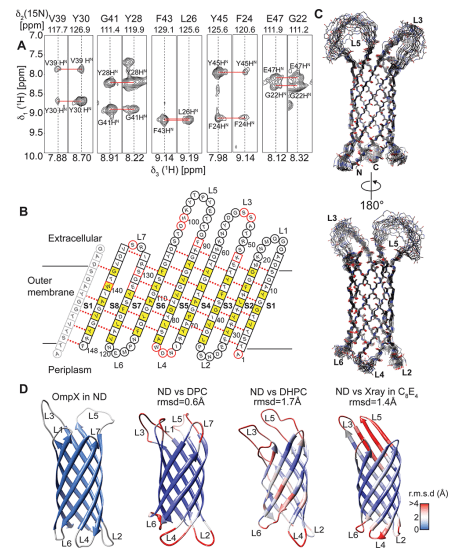Mempro™ Nuclear Magnetic Resonance (NMR) Spectroscopy
As an global leader in nanodiscs technolgy, Creative Biostructure offers customized Mempro™ nuclear magnetic resonance (NMR) spectroscopy service with our advanced nanodiscs analysis platform to meet clients’ demands.
NMR is a physical phenomenon in which nuclei in a magnetic field assimilate and re-emit electromagnetic radiation. The resonance frequency of this energy hinges on the power of the magnetic field and magnetic characteristics of the isotope of the atoms. In actual uses, the frequency resembles VHF and UHF television broadcasts (60–1000 MHz). NMR spectroscopy is a prevailing approach for analyzing organic compounds and protein structures. This technique is applied in biochemistry and inorganic chemistry, where it supplies a great deal of worthy structural information. It offers specified message about the dynamics, reaction state, structure, and the chemical state of the molecules. In addition, NMR spectroscopy is a unique method to acquire high-resolution message especially for partially or wholly constitutionally unstructured proteins.
 Figure 1. Structure determination of OmpX in nanodiscs. (Hagn, F. 2013)
Figure 1. Structure determination of OmpX in nanodiscs. (Hagn, F. 2013)
Nanodiscs Analysis Using NMR Spectroscopy
Nanodisc is an artificial model membrane system, which is composed of nearly 150 phospholipids encircled by a membrane scaffold protein (MSP) with a diameter of about 10 nm. Due to its outstanding features of rapid reorientation in aqueous solution, nanodiscs have gained special attention in yield of high-resolution solution of NMR spectra for membrane proteins in bilayer conditions. Numerous endeavors have been conducted to minimize the size of the protein-lipid complex for the sake of reducing the rotational correlation time and to acquire resonances with the narrowest line widths.
Meanings and prospects of NMR Spectroscopy
NMR Spectroscopy has turned into a potent analytical technology, and has been applied to a number of disciplines of scientific research, medicine and industries. This technique is the only approach for atomic-resolution structure determination of biomacromolecules in aqueous solutions under almost physiological environments or membrane mimeric states. Besides, it’s the best strategy for quantifying motional properties of biomacromolecules and detecting the residual structures of unfolded proteins and the structures of folding intermediates.
Creative Biostructure also provides other various Mempro™ nanodisc technology service, besides nanodiscs analysis. Please feel free to contact us for a detailed quote
References:
Hagn, F. (2013). “Optimized phospholipid bilayer nanodiscs facilitate high-resolution structure determination of membrane proteins”. Journal of the American Chemical Society, 135(5), 1919-1925.
Elipe, M. V. S. (2003). “Advantages and disadvantages of nuclear magnetic resonance spectroscopy as a hyphenated technique”. Analytica Chimica Acta, 497(1), 1-25.
Jeong, S. (2016). “Miniaturized Nuclear Magnetic Resonance Platform for Rare Cell Detection and Profiling”. Circulating Tumor Cells: Isolation and Analysis, 183-200.